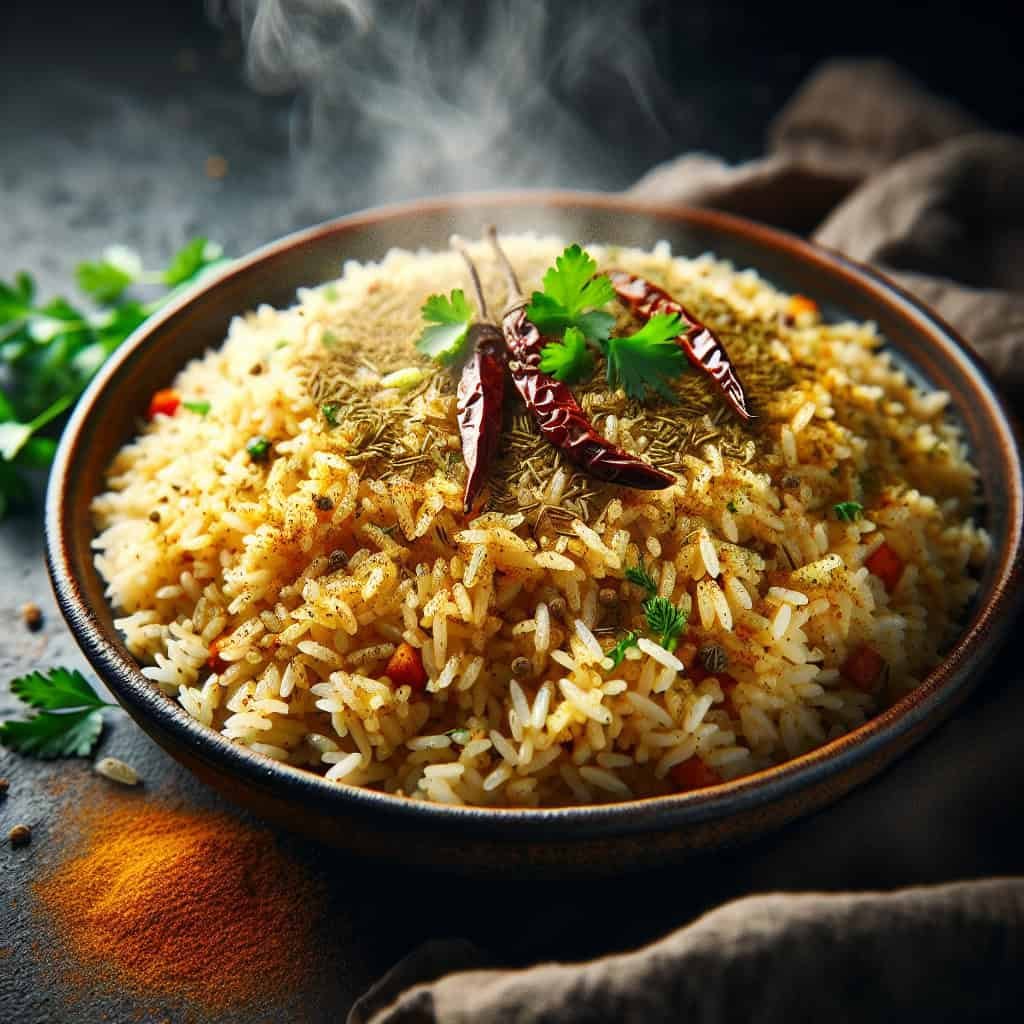If you’re searching for exciting Thanksgiving recipes to switch things up this year, look no further. An AP-NORC poll reveals that while Americans may have their differences when it comes to Thanksgiving classics, there seems to be unanimous agreement on one factor: the deliciousness of pumpkin pie. With debates over dark meat versus white meat in turkey and diverse preferences for side dishes, it’s time to bring something new to the table. How about trying a flavorful cuminy rice pilaf to complement your Thanksgiving feast? This aromatic dish offers a delightful twist on traditional rice dishes, adding a hint of cumin that will surely leave your taste buds craving for more. Get ready to impress your guests with this creative and delectable addition to your Thanksgiving spread.
Cuminy Rice Pilaf
Welcome to this comprehensive article on Cuminy Rice Pilaf! In this article, we will explore the delicious dish of Cuminy Rice Pilaf, its ingredients, preparation methods, variations, serving suggestions, tips and tricks, health benefits of cumin, history of rice pilaf, cultural significance, frequently asked questions, and a concluding note. So let’s dive right in!

Ingredients
To make a flavorful Cuminy Rice Pilaf, you will need the following ingredients:
- 1 cup of long-grain rice
- 2 cups of vegetable or chicken broth
- 1 tablespoon of olive oil
- 1 small onion, finely chopped
- 2 cloves of garlic, minced
- 1 teaspoon of ground cumin
- Salt and pepper to taste
- Chopped fresh cilantro or parsley for garnish (optional)
Preparation
Now that we have gathered our ingredients, let’s move on to how to prepare Cuminy Rice Pilaf:
- Start by rinsing the rice under cold water until the water runs clear. This helps remove excess starch and prevents the rice from sticking together.
- In a large saucepan or skillet, heat the olive oil over medium heat. Add the chopped onion and minced garlic, and sauté until they become translucent and fragrant.
- Add the ground cumin to the pan and toast it for a minute or until it becomes aromatic. Be careful not to burn it.
- Next, add the rinsed rice to the pan and stir it well, making sure each grain is coated with the onion, garlic, and cumin mixture.
- Pour in the vegetable or chicken broth and bring it to a boil. Once it starts boiling, reduce the heat to low, cover the pan with a lid, and let it simmer for about 15-20 minutes or until the rice is cooked and the liquid is absorbed.
- Once the rice is cooked, fluff it with a fork and season it with salt and pepper to taste. Garnish with chopped fresh cilantro or parsley if desired.
- Your Cuminy Rice Pilaf is now ready to be served!
Variations
While the traditional Cuminy Rice Pilaf is already delicious on its own, you can also experiment with some variations to add your own twist. Here are a few ideas:
- Vegetables: Add sautéed vegetables like bell peppers, carrots, peas, or corn to the pilaf for added flavor and texture.
- Protein: Include cooked chicken, shrimp, or tofu to make it a complete meal.
- Spices: Experiment with different spices such as turmeric, cinnamon, or cardamom to create unique flavor profiles.
- Nuts and Dried Fruits: Add some roasted nuts like almonds or cashews and dried fruits like raisins or cranberries to give the pilaf a sweet and savory balance.
Feel free to get creative and make it your own!
Serving Suggestions
Cuminy Rice Pilaf makes a versatile side dish that can complement a variety of main courses. Here are a few serving suggestions:
- Serve it alongside grilled chicken skewers for a flavorful and satisfying meal.
- Pair it with roasted vegetables for a vegetarian-friendly option.
- Use it as a base for stuffed peppers or vegetables for a wholesome and nutritious meal.
- Enjoy it as a side dish with your favorite protein, such as grilled steak or baked fish.
The options are endless, so choose whatever combination satisfies your taste buds!

Tips and Tricks
To ensure your Cuminy Rice Pilaf turns out perfect every time, here are some helpful tips and tricks:
- Use flavorful broth: The broth you use plays a crucial role in enhancing the overall taste of the pilaf. Opt for a good-quality vegetable or chicken broth to infuse the rice with maximum flavor.
- Toast the cumin: Toasting the cumin before adding it to the rice releases its aromatic oils, intensifying its flavor. Be careful not to burn it, as it can become bitter.
- Fluff the rice: After cooking, it’s important to fluff the rice with a fork. This separates the grains and prevents them from becoming sticky.
- Let it rest: Allowing the rice to rest for a few minutes after cooking can help the flavors meld together and create a more cohesive dish.
By following these tips, you’ll elevate your Cuminy Rice Pilaf to new heights!
Health Benefits of Cumin
Cumin, the star spice in Cuminy Rice Pilaf, not only adds a distinct flavor but also offers several health benefits. Here are a few notable ones:
- Digestive Aid: Cumin has been traditionally used to aid digestion by stimulating the production of enzymes. It may help reduce bloating, indigestion, and other gastrointestinal discomforts.
- Antioxidant Properties: Cumin contains antioxidants that help neutralize harmful free radicals in the body, protecting against oxidative stress and reducing the risk of chronic diseases.
- Anti-Inflammatory Effects: The active compounds in cumin, such as thymoquinone, have shown anti-inflammatory properties, which may help alleviate symptoms of inflammation.
- Rich in Iron: Cumin is a good source of iron, an essential mineral that plays a vital role in the production of healthy red blood cells and oxygen transport in the body.
Adding cumin to your dishes not only enhances the taste but also brings potential health benefits to your plate.

History of Rice Pilaf
The origins of rice pilaf can be traced back to ancient Persia (modern-day Iran). It was a beloved dish of the Persian royalty, known for its fragrant aroma and delicate flavors. Rice pilaf soon spread throughout the Middle East and became a staple dish in many cultures.
In traditional rice pilaf, rice is first sautéed in oil or butter to bring out its nutty flavor before simmering it with broth or water. This technique gives rice pilaf its distinct texture and separates it from other rice dishes. Over time, variations of rice pilaf emerged, incorporating different spices, meats, and vegetables, depending on the region and local cuisine.
Cultural Significance
Rice pilaf holds cultural significance in various parts of the world. It is often served during special occasions, festivals, and family gatherings, symbolizing abundance, prosperity, and togetherness.
In Middle Eastern cuisine, rice pilaf is a common accompaniment to dishes such as kebabs and stews. In Mediterranean countries, it is a traditional side dish served alongside grilled meats and seafood. The dish has also found its way into various global cuisines, including Indian, Central Asian, and Caribbean.
Whether it’s enjoyed in a family feast or a celebratory event, rice pilaf continues to bring people together and celebrate culinary traditions across different cultures.

Frequently Asked Questions
- Can I use brown rice instead of white rice? Yes, you can substitute brown rice for white rice in this recipe. However, note that the cooking time may differ, and you may need to adjust the amount of broth or water for it to cook properly.
- Is cumin spicy? Cumin is not spicy on its own. It has a warm and earthy flavor with a slight hint of smokiness. The level of spiciness in a dish depends on the other spices and ingredients used.
- Can I make rice pilaf in an Instant Pot or rice cooker? Yes, you can adapt the recipe to make rice pilaf in an Instant Pot or rice cooker. Adjust the liquid proportions and cooking time according to the instructions of your appliance.
- Can I freeze leftover rice pilaf? Yes, you can freeze leftover rice pilaf in an airtight container for up to 3 months. Thaw it in the refrigerator overnight and reheat it in the microwave or on the stovetop before serving.
Conclusion
In conclusion, Cuminy Rice Pilaf is a flavorful and versatile dish that can elevate any meal. With its aromatic cumin, delicate rice grains, and a hint of onion and garlic, it’s sure to be a crowd-pleaser. Whether you enjoy it as a side dish, a main course with added protein, or as part of a larger feast, Cuminy Rice Pilaf offers a delicious and nutritious option. So why not give it a try and impress your family and friends with this delightful dish? Happy cooking!
